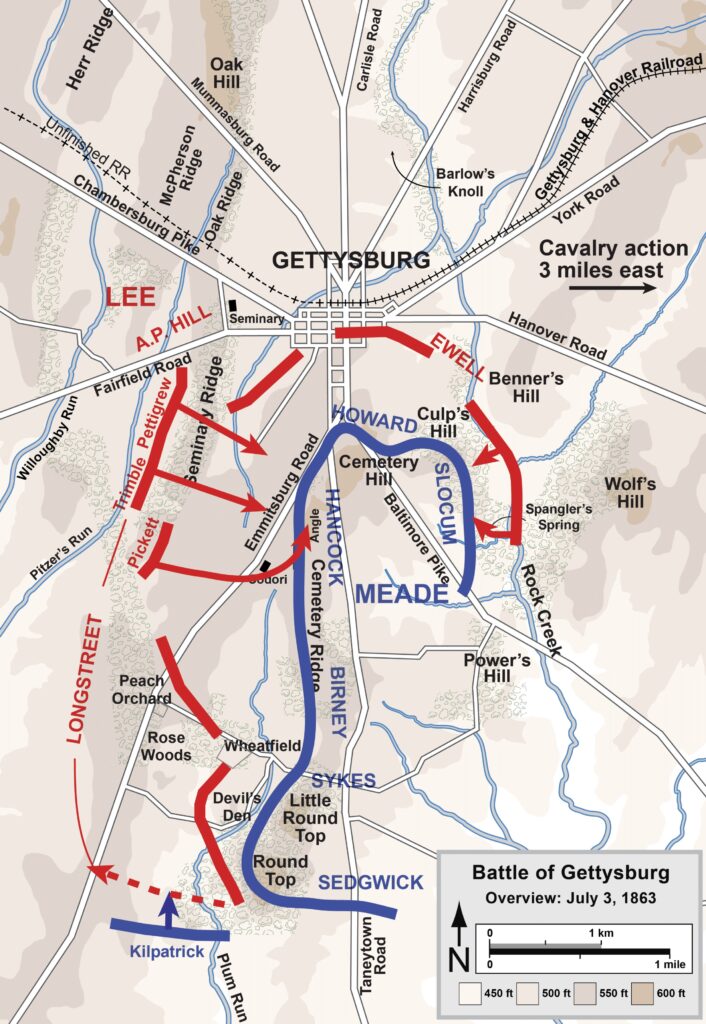Early in the morning on Gettysburg day 3, July 3rd, 1863, Union batteries from the XII Corp opened up on Confederate positions on lower Culp's Hill. General Johnson was ordered to attack the Union positions at the top of Culp's Hill, which had been reinforced overnight by units from the I and VI Corps and was significantly stronger from the day before.

Johnson attacked multiple times but was repulsed on each attempt. The fighting on Culp's Hill ended around 11 a.m. with no advantage gained, and preparations were being made by the Confederates for the next phase of the battle. Lee had planned to attack the Union positions in a similar fashion as the day before, but the Union artillery bombardment early in the morning on Culp's Hill on Gettysburg day 3 had forced the Confederates to develop another strategy.
Battle of Gettysburg Day 3: Planning Pickett's Charge
Robert E. Lee decided on a frontal assault on the Union Center at Cemetery Ridge with close to 12,000 men under the command of General Longstreet. Close to 160 Confederate artillery pieces would soften up the Union defenses prior to the advance of the infantry. Then, once the infantry advanced, they would have conserved enough ammunition to support the attack.
The Confederate artillery barrage began at 1 p.m., and its prime objective was to inflict damage on Union artillery prior to the advance of the infantry. After 30 minutes, the Union artillery returned fire with about 80 cannons. Most of the Confederate shells overshot their targets and did not inflict much damage to the Union defenses.
Battle of Gettysburg Day 3: The Attack
Around 3 p.m., the Confederates were running very low on artillery ammunition, and the attack was ordered by Longstreet. Close to 12,000 Confederate soldiers with ranks stretching a mile long stepped out of the protection of woods and began the ¾ mile march to reach the Union lines on Cemetery Ridge.
Major General George E. Pickett led his men on the Confederate right, and Brigadier General James J. Pettigrew led his men down the left. As they advanced closer to the Union lines, they were to converge in the center of the Union position called the Angle.
From the moment the Confederates advanced toward the Union lines, they were hit with long-range flanking artillery fire from north of Little Round Top and Cemetery Ridge. A fence in the middle of the advance further slowed the Confederate advance and split up the ranks into disorganized groups.
The Union artillery in the center had ceased firing toward the initial artillery barrage, thereby making the Confederates believe they had been knocked out. At a critical moment, they were turned on the advancing Confederates with devastating results.
Despite their losses, the Confederates continued to converge and advance toward the low stone wall at the Union position known as the Angle. General Winfield S. Hancock commanded II Corps in the Union center and was wounded during Gettysburg Day 3.
As the remaining Confederates advanced toward the center, the Union troops were able to flank them on both sides and continued the murderous fire into the ranks. Under a final charge led by Confederate Brigadier General Lewis A. Armistead, a commander under Pickett, they momentarily broke through the Union center and, by storming the Angle, were able to able to capture some artillery.
This is referred to as the "High-water mark of the Confederacy" as it is considered the closest the Confederacy came to defeating the Union in achieving ultimate victory. The Union center, however, was quickly reinforced, and the Confederates were unable to support their initial success with reinforcements of their own, and the attack thereafter was known as "Pickett's Charge."
The Confederate lines were forced into full retreat, and roughly 50% of the 12,000 making the charge were killed, wounded, or missing at Gettysburg. The Union losses are generally estimated at 1,500.
The cavalry on both sides saw significant action on the third day. Confederate Cavalry General J.E.B. Stuart was ordered by General Lee to guard the Confederate left flank and to capitalize on any success by the infantry. Three miles east of Gettysburg in what is now known as "East Cavalry Field," Stuart's cavalry met divisions under Brigadier General David McMurtrie Gregg and Brigadier General Armstrong Custer. The fighting was fierce and included hand-to-hand saber duels. No advantage was gained by either side, and most importantly, Stuart was unsuccessful in supporting the Confederate advance.
